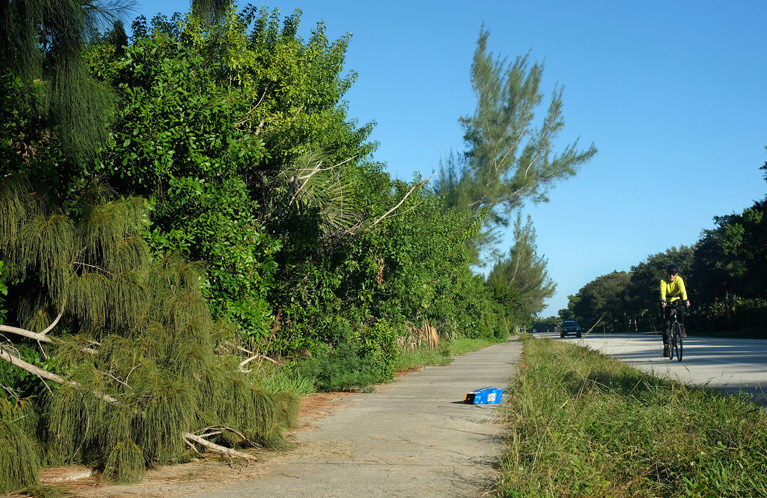
For the past 10 years, week in and week out, we’ve tried to provide island readers with information they don’t get elsewhere about the electric system, the hospital, the public schools, city and county government – the big issues that impact the lives of all who live here.
But with another Thanksgiving upon us, I’d like to share a story that demonstrates the kind of hyper-local journalism we also do at Vero Beach 32963.
What follows is not anywhere near the sexiest or most important story I’ve ever worked on. I have no idea how many of you will be affected, or even care. But it made a difference to at least a few folks – maybe a big difference. For someone who has spent his entire life as a newspaperman, that’s no small thing.
It’s why I do this job. It’s also why I’m thankful to have been given the opportunity to do this job in such a special community.
Certainly, it’s why island resident Ralph Sheppard sent us an email last week, sharing photographs and his concerns about a potentially dangerous situation on a quarter-mile stretch of sidewalk on the west side of State Road A1A, immediately south of The Moorings, from Spyglass Lane to Island Drive. He needed our help.
He wanted us to identify the governmental agency responsible for maintaining that property and ask why it hadn’t cleared the intrusive vegetation that, in some areas, blocked most of the heavily trafficked sidewalk, forcing pedestrians and bicyclists to walk or ride on the grass along the edge of the roadway.
“The people I speak with claim they have reached out to the county with no response,” Sheppard wrote. “I thought maybe I could solicit a response from our local newspaper, since you have always been so deeply involved with the island and its issues.”
He came to the right place.
In his email, Sheppard, who lives on Harbor Lane, wrote that he walks this sidewalk every day, along with many others who live in that area. He said the vegetation hadn’t been trimmed in years and, in recent months, the problem had become a safety hazard.
“It has continued to deteriorate and is now presenting a very serious and dangerous condition whereby we are forced off the sidewalk, with our dogs and strollers, because the vegetation from the adjoining lot has overtaken any possible means of egress,” he wrote.
He then referred to the photos, which clearly showed the vegetation blocking much of the sidewalk – so much so pedestrians have worn a dirt path in the grass, and that path is frighteningly close to the edge of the highway, where traffic often travels at more than 50 mph.
“It is criminal that, with all of our property taxes, we still can’t get some basic services,” Sheppard wrote. “Maybe the county will wait until someone is hit by one of the speeding cars on A1A before they address these concerns.”
When I spoke with Sheppard, he reiterated much of what was in his email, especially the part about “lots of people” using that sidewalk and having “no doubt” in his mind that “someone is going to get hurt, maybe killed” by a passing motor vehicle.
“There’s a bike lane, but it’s only 4 feet wide, and you always see drivers looking at their phones or texting, not focused on the road,” he said. “I’ve seen cars drift onto the white line.”
He also mentioned pedestrians who break off branches by hand as they try to squeeze through the vegetation, leaving sharp edges that “can rake your arm as you walk by.”
The more we talked, the more his frustration became obvious.
“It’s been bad in the past, but they never let it get this bad,” Sheppard said, finally adding, “It’s Vero Beach, the barrier island. But we’re in the unincorporated county, so I guess we’re the odd man out. Maybe you can find out why.”
I did.
I started with a call to County Administrator Jason Brown, who referred me to Public Works Director Rich Szpyrka, who, after checking a map, referred me to the Florida Department of Transportation, the agency responsible for maintaining the right-of-ways on state roads, including sidewalks.
So I called Barbara Kelleher, the agency’s public information officer for the FDOT district that includes our county, and explained the situation. She said she’d check into it and get back to me.
Less than an hour later, Kelleher responded with an email that said she had contacted FDOT’s maintenance contractor, DBI Services, and a work crew would remedy the problem, possibly as soon as the next day. She also thanked me for “bringing this to our attention.”
One of our photographers saw a crew on the site Saturday morning.
When I called Sheppard and told him of FDOT’s prompt response, he, too, thanked me – which was nice, but not necessary.
It wasn’t just my assignment, it was my pleasure.
It’s why I do this job, and why I’m thankful to have the opportunity to do it here, as part of a great team of journalists.
Happy Thanksgiving.



